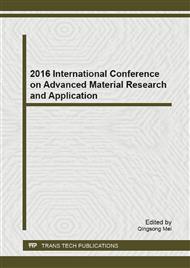[1]
He Honghua, Wan Xiaohang. The Influence of Cutting Corner Radius on the Cutting Process of Numerical Analysis [J]. Journal of Mechanical Transmission, 2009, 02: 86-87+104.
Google Scholar
[2]
GAO Teng, MIAO Hong-bin, JIANG Min. Effect of Tool Nose Radius to Difficult Cutting Material on Surface Roughness [J]. Coal Mine Machinery, 2013, 08: 149-150.
Google Scholar
[3]
Du Yuzhen, Zhou Li. Influence of Tool Corner Radius on Edge Defects in Machining of SiCp /Al Composites [J]. Tool Engineering, 2014, 05: 45-48.
Google Scholar
[4]
ZHU Jianjun, TANG Jia, ZHAO Zhonghua. Influence of Round Radius of Turning Cutter Tip on the Manufacturing Process[J]. Research and Exploration in Laboratory, 2012, 10: 254-257.
Google Scholar
[5]
He Yuhui, Chen Yongjie, Chen Shikui. Influence of Cutting Corner Radius on the Metal Cutting Process[J]. Cemented Carbide, 2003, 01: 25-28.
Google Scholar
[6]
Fan Ning, Chen Ming, Wang Hui. Simulation of Cutting Tool Geometry Parameters Impact on Residual Stresses[J]. Machine Tool & Hydraulics, 2009, 11: 30-31+48.
DOI: 10.1109/ccdc.2009.5191873
Google Scholar
[7]
Jia Te, Li Man, Zhang Hongtao, et al. Effect of Geometric Parameter of PCD Tool on Cutting Force in Turning Aluminum Alloy[J]. Tool Engineering, 2007, 04: 32-35.
Google Scholar
[8]
Wu Hongbing, Liu Gang, Bi Yunbo, Dong Huiyue. Influence of Tool Geometrical Parameters on High Speed Cutting of Titanium Alloy Ti6Al4V [J]. China Mechanical Engineering, 2008, 20: 2419-2422.
Google Scholar
[9]
P. I. Varela, C. S. Rakurty, A. K. Balaji. Surface Integrity in Hard Machining of 300M Steel: Effect of Cutting-Edge Geometry on Machining Induced Residual Stresses. 2nd CIRP 2nd CIRP Conference on Surface Integrity(CSI). May 28-30 2014[C]. Nottingham.
DOI: 10.1016/j.procir.2014.04.049
Google Scholar
[10]
K.C. Ee, O.W. Dillon Jr., I.S. Jawahir. Finite element modeling of residual stresses in machining induced by cutting using a tool with finite edge radius[J]. International Journal of Mechanical Sciences: 47 (2005) 16111628.
DOI: 10.1016/j.ijmecsci.2005.06.001
Google Scholar
[11]
A. Muoz-Snchez, J.A. Canteli, J.L. Cantero, et al. Numerical analysis of the tool wear effect in the machining induced residual stresses [J]. Simulation Modelling Practice and Theory, 2010(19): 872-886.
DOI: 10.1016/j.simpat.2010.11.011
Google Scholar
[12]
Mohamed N.A. Nasr, E. -G. Ng, M.A. Elbestawi. A modified time-efficient FE approach for predicting machining-induced residual stresses [J]. Finite Elements in Analysis and Design. 44 (2008) 149 161.
DOI: 10.1016/j.finel.2007.11.005
Google Scholar


